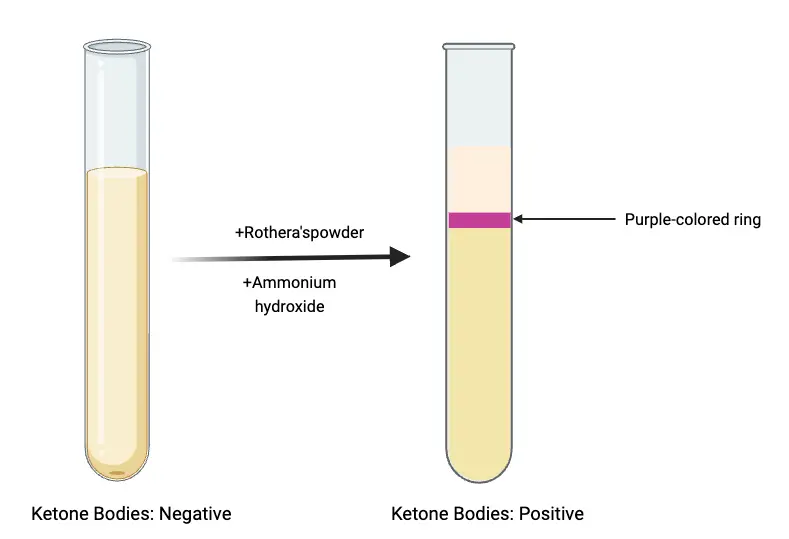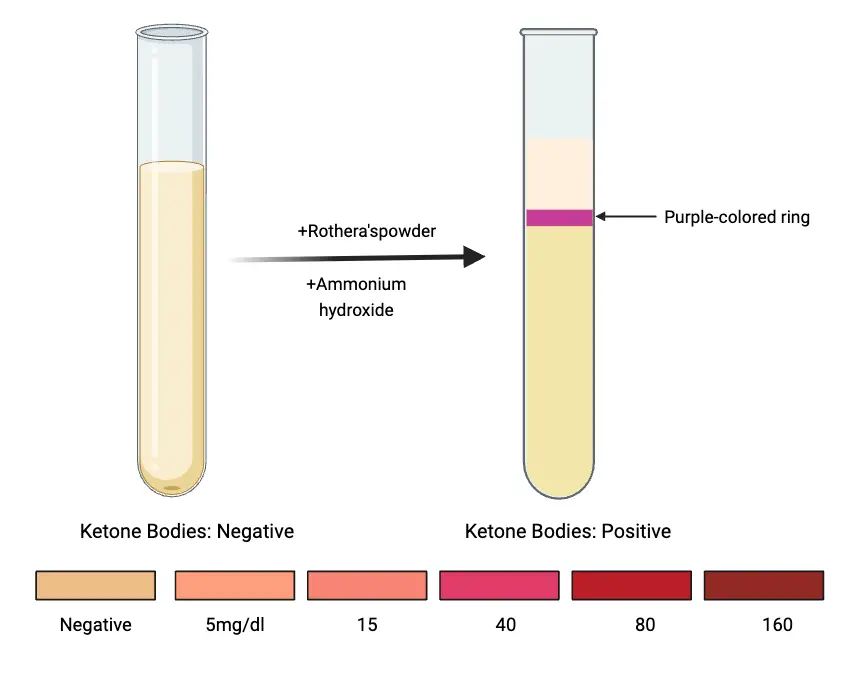What is Rothera’s test?
- Rothera’s test is a diagnostic procedure used to detect the presence of ketone bodies in urine. Ketone bodies are produced during the metabolism of fats, and under normal physiological conditions, they are typically broken down into water and carbon dioxide, resulting in negligible levels in the urine.
- Rothera’s test specifically identifies ketone bodies, which include acetone, acetoacetic acid, and beta-hydroxybutyrate. This test is particularly useful in conditions where the production of ketone bodies exceeds normal levels, such as in cases of ketonuria. Ketonuria often occurs in conditions like starvation, diabetes mellitus, prolonged vomiting, severe diarrhea, and high-fat or low-carbohydrate diets.
- In Rothera’s test, the urine sample is mixed with a reagent containing sodium nitroprusside. The presence of ketone bodies is indicated by a color change in the sample, which turns to a reddish or purple hue if ketones are present. This color change is due to the reaction between the ketone bodies and the nitroprusside reagent, confirming the presence of excess ketones in the urine.
- Therefore, Rothera’s test is a valuable tool in clinical diagnostics for detecting ketone bodies and assessing metabolic states associated with increased ketone production.
Definition of Rothera’s test
Rothera’s test is a diagnostic laboratory procedure used for the qualitative detection of ketone bodies in urine, commonly employed to identify conditions like uncontrolled diabetes or starvation where increased fat metabolism leads to elevated ketone production.
What is the aim of Rothera’s test?
- To detect the presence of Ketone bodies within the supplied urine sample.
What is the principle of Rothera’s test?
The principle of Rothera’s test relies on the chemical reaction between ketone bodies and sodium nitroprusside in an alkaline solution. This test is specifically designed to detect acetoacetic acid and acetone, two of the three primary ketone bodies produced during fat metabolism.
When urine containing acetoacetic acid or acetone is mixed with an alkaline sodium nitroprusside solution, a distinctive chemical reaction occurs. The ketone bodies react with the sodium nitroprusside to form a purple-colored complex. This color change is a key indicator of the presence of these ketones in the urine. The test can reliably detect concentrations of acetoacetic acid as low as 1-5 mg/dl and acetone as low as 10-20 mg/dl.
However, it is important to note that Rothera’s test does not detect beta-hydroxybutyrate, the third ketone body. Therefore, while the test is useful for identifying acetoacetic acid and acetone, it does not provide information about the presence of beta-hydroxybutyrate in the urine. Thus, Rothera’s test is effective for detecting specific ketone bodies but has limitations in its scope of detection.

What are the requirements for Rothera’s test?
To perform Rothera’s test effectively, several requirements must be met:
- Urine Specimen: A sample of urine is essential for conducting the test, as it is the medium in which ketone bodies are detected.
- Test Tubes: Clean test tubes are required to mix and analyze the urine sample with the reagents.
- Rothera’s Powder: This consists of two key components:
- Sodium Nitroprusside (0.75 grams): A reagent that reacts with ketone bodies.
- Ammonium Sulfate (20 grams): Added to the sodium nitroprusside and then mixed and pulverized to form the powder.
- Liquor Ammonia (Ammonium Hydroxide): This is used to create an alkaline environment necessary for the reaction between sodium nitroprusside and ketone bodies.
What is the procedure for Rothera’s test?
- Prepare the Test Tube: Begin with a clean, sterile test tube to ensure no contamination affects the results.
- Add Urine Sample: Transfer approximately 5 ml of the urine sample into the prepared test tube.
- Incorporate Rothera’s Powder: Add 1 gram of the pre-prepared Rothera’s powder mixture to the urine. This powder consists of sodium nitroprusside and ammonium sulfate. Mix the solution thoroughly to ensure even distribution of the powder.
- Add Ammonium Hydroxide: Carefully layer 1-2 ml of concentrated ammonium hydroxide (liquor ammonia) on top of the urine mixture. This step is crucial as it creates an alkaline environment necessary for the reaction.
- Observe the Result: Examine the interface between the urine and ammonium hydroxide. A positive result is indicated by the formation of a pink-purple ring at the boundary of the two layers.
What are the results of Rothera’s test?
- Positive Result:
- Observation: The immediate formation of a purple permanganate-colored ring at the interface between the urine and ammonium hydroxide.
- Interpretation: This indicates the presence of ketone bodies, such as acetoacetic acid or acetone, in the urine. The presence of this ring confirms a positive result for ketonuria.
- Negative Result:
- Observation: The absence of a purple permanganate-colored ring at the interface.
- Interpretation: This indicates that ketone bodies are not present in the urine. Thus, the result is negative.
- Grading the Result:
- Trace: Very faint purple ring.
- +: Slightly visible purple ring.
- ++: Moderately intense purple ring.
- +++: Strong purple ring.
- ++++: Very intense purple ring.

| Result | Observation | Interpretation |
|---|---|---|
| Positive | Immediate formation of a purple permanganate-colored ring at the interface | Presence of ketone bodies (acetoacetic acid or acetone) |
| Negative | No formation of a purple permanganate-colored ring at the interface | Absence of ketone bodies |
| Trace | Very faint purple ring | Minimal presence of ketone bodies |
| + | Slightly visible purple ring | Low concentration of ketone bodies |
| ++ | Moderately intense purple ring | Moderate concentration of ketone bodies |
| +++ | Strong purple ring | High concentration of ketone bodies |
| ++++ | Very intense purple ring | Very high concentration of ketone bodies |
What are the Applications of Rothera’s test?
- Diagnosis of Ketosis:
- Purpose: To detect the presence of ketone bodies in urine, which can indicate ketosis.
- Context: Useful in conditions such as uncontrolled diabetes mellitus or starvation where the body shifts to fat metabolism.
- Management of Diabetes Mellitus:
- Purpose: To monitor ketone levels in diabetic patients.
- Context: Helps in assessing the risk of diabetic ketoacidosis (DKA) and adjusting insulin therapy accordingly.
- Evaluation of Metabolic States:
- Purpose: To evaluate metabolic disturbances related to increased fat metabolism.
- Context: Useful in clinical settings to assess the impact of dietary changes or metabolic disorders.
- Assessment During Fasting or Starvation:
- Purpose: To detect ketone production due to prolonged fasting or starvation.
- Context: Helps in understanding the extent of ketosis and its impact on overall health.
- Clinical Research:
- Purpose: To study the role of ketone bodies in various metabolic and pathological conditions.
- Context: Used in research settings to explore metabolic pathways and treatment options for related disorders.
What safety precautions should be taken when performing Rothera’s test?
When conducting the Rothera Test, it is imperative to adhere to specific safety precautions to ensure the accuracy of results and prevent potential hazards. Here’s a detailed overview of the safety measures based on the provided content:
- Apparatus Sterilization: Prior to the test, ensure that all apparatus, especially those requiring sterility, are thoroughly cleaned and sterilized. This step is crucial to prevent contamination which might interfere with the test results.
- Chemical Handling: All chemicals, including reagents used in the test, should be handled with utmost care. Proper techniques should be employed to prevent spillage, breakage, or any other accidents that might compromise the safety of the experiment.
- Avoid Direct Contact with Urine: It is essential to avoid direct skin contact with the urine sample. Utilize appropriate tools and wear protective gloves when handling urine specimens to prevent potential contamination and ensure personal safety.
- Use of Test Tube Holders: When manipulating test tubes, especially those containing specimens or reactive chemicals, always use test tube holders. Direct handling with bare hands can pose risks, especially if the test tube is hot or contains hazardous substances.
- Proper Storage of Apparatus: After the completion of the test, all apparatus should be cleaned and stored in their designated places. This not only ensures the longevity of the equipment but also minimizes the risk of accidents in the laboratory.
Quiz
What is the primary purpose of Rothera’s Test?
a) To detect glucose in urine
b) To detect proteins in urine
c) To detect ketone bodies in urine
d) To detect blood in urine
Which of the following is NOT detected by Rothera’s Test?
a) Acetone
b) Acetoacetic acid
c) Beta-hydroxybutyrate
d) Glucose
What color indicates a positive Rothera’s Test?
a) Blue
b) Green
c) Pink-purple
d) Yellow
Which chemical is used in Rothera’s Test to form a colored complex with ketone bodies?
a) Sodium chloride
b) Sodium nitroprusside
c) Sodium bicarbonate
d) Sodium hydroxide
In which condition is ketonuria commonly observed?
a) Hypertension
b) Uncontrolled diabetes
c) Anemia
d) Dehydration
Which layer is formed on top during the Rothera’s Test procedure?
a) Urine layer
b) Acetone layer
c) Ammonium hydroxide layer
d) Water layer
What is the significance of a negative Rothera’s Test?
a) Presence of ketone bodies in urine
b) Absence of ketone bodies in urine
c) Presence of glucose in urine
d) Presence of proteins in urine
Which of the following is a component of Rothera’s powder?
a) Ammonium chloride
b) Ammonium sulphate
c) Ammonium carbonate
d) Ammonium nitrate
In which layer does the pink-purple ring appear in a positive Rothera’s Test?
a) At the bottom
b) In the middle
c) At the interface
d) Throughout the test tube
Which of the following conditions can lead to increased production of ketone bodies?
a) Overhydration
b) High carbohydrate diet
c) Starvation
d) High protein diet
FAQ
What is Rothera’s Test used for?
Rothera’s Test is a qualitative laboratory test used to detect the presence of ketone bodies in urine.
Why is it important to detect ketone bodies in urine?
Detecting ketone bodies in urine can indicate conditions like uncontrolled diabetes or starvation, where the body starts breaking down fats for energy, leading to ketone production.
How is Rothera’s Test performed?
The test involves adding a specific amount of Rothera’s powder to a urine sample in a test tube, followed by layering with ammonium hydroxide. A positive result is indicated by the formation of a pink-purple ring at the interface.
What does a positive Rothera’s Test indicate?
A positive result, indicated by a pink-purple ring, means that ketone bodies are present in the urine.
Can Rothera’s Test detect all types of ketone bodies?
No, Rothera’s Test primarily detects acetoacetic acid and acetone. It does not detect beta-hydroxybutyrate.
Is Rothera’s Test specific to diabetes?
While the test is commonly used to detect ketonuria in diabetic patients, it can also indicate ketonuria due to other conditions like starvation or prolonged vomiting.
How accurate is Rothera’s Test?
Rothera’s Test is a qualitative test, meaning it can confirm the presence or absence of ketone bodies but does not quantify their concentration. It is considered reliable for detecting ketonuria.
Are there any other tests to detect ketone bodies in urine?
Yes, there are other tests like Gerhardt’s test, Lang’s test, and tablet tests. However, many of these are based on the principle of Rothera’s nitroprusside test.
What precautions should be taken while performing Rothera’s Test?
It’s essential to handle chemicals with care, avoid direct contact with urine samples, use sterilized apparatus, and always use test tube holders when handling test tubes.
Can I perform Rothera’s Test at home?
While there are home-based urine ketone test strips available, Rothera’s Test is typically performed in a laboratory setting due to the chemicals involved and the need for accurate interpretation of results.
- Text Highlighting: Select any text in the post content to highlight it
- Text Annotation: Select text and add comments with annotations
- Comment Management: Edit or delete your own comments
- Highlight Management: Remove your own highlights
How to use: Simply select any text in the post content above, and you'll see annotation options. Login here or create an account to get started.